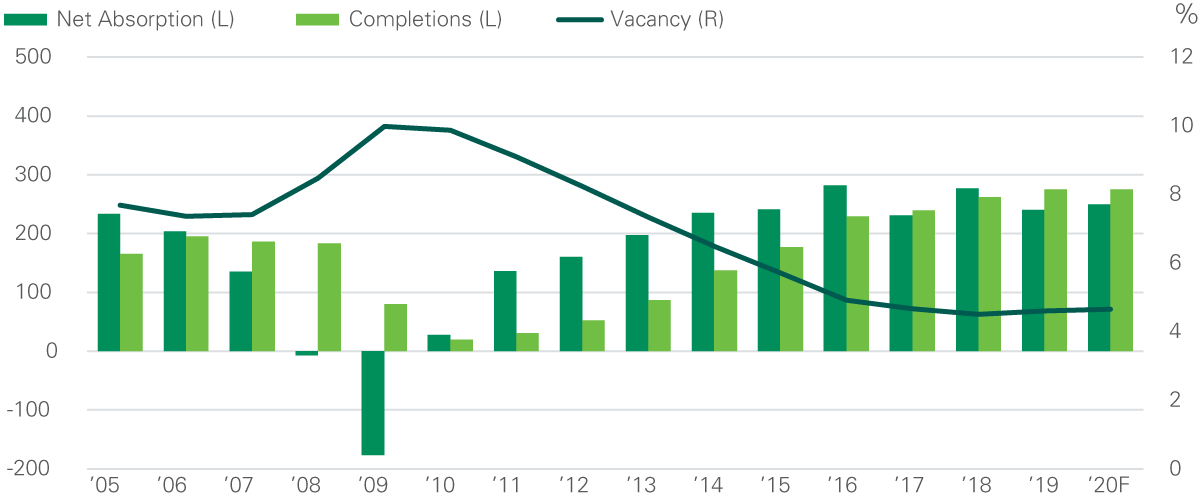
The Broad View
- Prologis’ IBI™, our proprietary survey of customer sentiment, accelerated in Q4 2019 to end the year at 61.4. Utilization rose to 87%—the strongest point since December 2018—indicating that there is little shadow space in the market as customers fully use existing facilities.
- Absorption kept pace with new supply throughout most of 2019, with demand supported by healthy consumption growth, as well as structural drivers. Further, seasonality drove deliveries, many of which are still in the lease-up phase.
- Prologis Research anticipates net absorption of 250 MSF and 275 MSF of completions in 2020, which will keep the vacancy rate historically low at roughly 4.6% to 4.7%.1
- Market rental growth of 8% in 20192 reflects two key factors: the scarcity of available product and rising replacement costs in most markets. That said, conditions have eased for customers in select locations.3
Exhibit 1
IBI ACTIVITY INDEX
Index, 50 = neutral, seasonally adjusted
Exhibit 2
MARKET FUNDAMENTALS, U.S.
MSF

The Details
Logistics real estate demand was diverse and strong, supported by cyclical and structural trends. Demand grew by approximately 240 MSF in 2019, down slightly from the elevated levels of 2018.4 Despite a record-long economic expansion, cyclical growth in the U.S. remained on solid footing as consumption accelerated toward the close of the year.5 On the structural side, e-commerce users were very active throughout 2019 (bringing with them a broadening array of requirements),6 and they are poised to expand further in 2020. Net absorption is expected to rise by 250 MSF in 2020.
Supply increased in lower-barrier locations. The development pipeline expanded in 2019 as a response to strong investor interest in logistics real estate. Supply remains concentrated in markets with lower barriers to new development. Locations at risk of oversupply include Central PA and outlying submarkets in Houston and Atlanta. Completions increased to 275 MSF in 2019, up 3% from 262 MSF in 2018.7 Supply is expected to total 275 MSF in 2020, as the volume of projects breaking ground stabilized in 2019. With demand constrained by available capacity, net absorption is closely linked to new supply, and Prologis Research anticipates that both will rise slightly in 2020. Supply/demand imbalance is mostly the result of “frictional vacancy,” as higher levels of new supply take time to lease up. The national vacancy rate is expected to remain roughly stable in the near term, keeping the operating environment challenging for customers with upcoming requirements.
Rental growth responded to persistent scarcity and rising replacement costs. These trends were exacerbated in the coastal metropolis markets that drove 8% market rental growth in 2019. Land price spikes, particularly, pushed construction costs of logistics buildings to new heights in most markets, with the fastest growth in infill submarkets well-positioned for Last Touch® and City Distribution.8 Developers must charge higher rental rates to make new projects financially feasible.
Exhibit 3
UTILIZATION RATE
%
Exhibit 4
SUMMARY OF NET ABSORPTION INDICATORS
Exhibit 5
UNDER CONSTRUCTION, U.S. INDUSTRIAL
MSF
In Summary
The U.S. logistics real estate market is poised for another year of expansion. Cyclical and structural growth drivers are incentivizing customers to invest in logistics capabilities to generate revenue and achieve operational efficiencies. Supply is responding to years of strong demand, robust market rent growth and tight operating conditions. Looking ahead, Prologis Research forecasts continued diversity in demand and sustained low vacancy, making advanced planning an ongoing priority for logistics customers.
Endnotes
Forward-Looking Statements
This material should not be construed as an offer to sell or the solicitation of an offer to buy any security. We are not soliciting any action based on this material. It is for the general information of customers of Prologis.
This report is based, in part, on public information that we consider reliable, but we do not represent that it is accurate or complete, and it should not be relied on as such. No representation is given with respect to the accuracy or completeness of the information herein. Opinions expressed are our current opinions as of the date appearing on this report only. Prologis disclaims any and all liability relating to this report, including, without limitation, any express or implied representations or warranties for statements or errors contained in, or omissions from, this report.
Any estimates, projections or predictions given in this report are intended to be forward-looking statements. Although we believe that the expectations in such forward-looking statements are reasonable, we can give no assurance that any forward-looking statements will prove to be correct. Such estimates are subject to actual known and unknown risks, uncertainties and other factors that could cause actual results to differ materially from those projected. These forwardlooking statements speak only as of the date of this report. We expressly disclaim any obligation or undertaking to update or revise any forward-looking statement contained herein to reflect any change in our expectations or any change in circumstances upon which such statement is based.
No part of this material may be (i) copied, photocopied or duplicated in any form by any means or (ii) redistributed without the prior written consent of Prologis.
About Prologis Research
Prologis’ Research department studies fundamental and investment trends and Prologis’ customers’ needs to assist in identifying opportunities and avoiding risk across four continents. The team contributes to investment decisions and long-term strategic initiatives, in addition to publishing white papers and other research reports. Prologis publishes research on the market dynamics impacting Prologis’ customers’ businesses, including global supply chain issues and developments in the logistics and real estate industries. Prologis’ dedicated research team works collaboratively with all company departments to help guide Prologis’ market entry, expansion, acquisition and development strategies.
About Prologis
Prologis, Inc. is the global leader in logistics real estate with a focus on high-barrier, high-growth markets. As of December 31, 2019, the company owned or had investments in, on a wholly owned basis or through co-investment ventures, properties and development projects expected to total approximately 814 million square feet (76 million square meters) in 19 countries.
Prologis leases modern distribution facilities to a diverse base of approximately 5,000 customers across two major categories: business-to-business and retail/online fulfillment.


